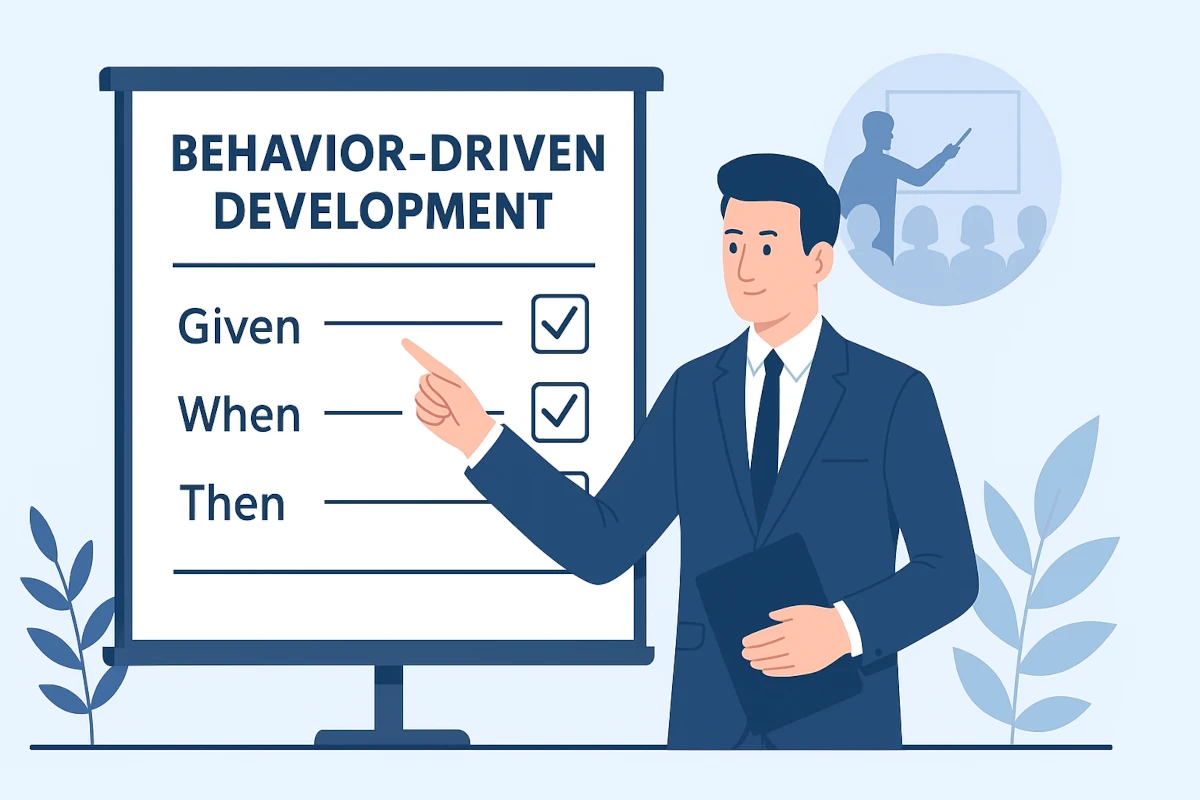
What Is Behavior‑Driven Development (BDD)?
What Is Behavior‑Driven Development (BDD)?
Introduction
We often see the tension: product folks talk about features and outcomes, while engineers talk about methods, APIs, tests. Behavior‑Driven Development (BDD) is a bridge between those worlds.
BDD starts from behavior, expressed in a shared language, and connects it to executable tests — so everyone speaks the same language, and behavior drives the design.
In BDD, behaviors are at the core: you describe what the system should do, using examples and scenarios, before worrying about how. That makes intent clear, and reduces misunderstandings.
Definition
Behavior‑Driven Development (BDD) is a software development methodology that emphasizes collaboration among product, QA, and engineering, using a common language of behavior expressed in natural, human-readable form. These behavioral specifications become executable tests that validate the system’s behavior.
BDD blends practices from Test-Driven Development (TDD) and Acceptance Test–Driven Development (ATDD), but adds a stronger focus on shared understanding, domain language, and behavior examples.
Why BDD Matters
✅ Better Alignment Between Business & Engineering
Teams collaborate early: product and domain experts help craft behavior examples. That ensures both intent and edge cases are considered upfront.
✅ Readable, Living Documentation
Behavior specs are written in plain language (e.g. “Given … When … Then …”) so non‑technical stakeholders can review and understand.
✅ Tests That Double as Specs
Because these behavior descriptions are also executable, they tie requirements and validation tightly together.
✅ Early Discovery of Ambiguities
Parsing behavior in examples forces you to think through edge cases and unclear requirements before coding begins.
✅ Improved Confidence During Refactoring & Change
As behavior tests capture expected logic, you can refactor or extend with lower risk — behavior must remain correct.
Common Concerns (And Responses)
-
“BDD sounds like extra overhead”
Yes, writing behavior scenarios takes effort. But it pays off by reducing rework and misunderstandings later. Use BDD selectively—start with critical features. -
“Behavior specs get out of sync”
Treat these specs as living — they must be maintained alongside code. Use frameworks that link them to execution so failures reveal mismatches. -
“Not all behavior is easy to express in plain language”
Some internal logic or algorithmic behavior may remain in lower-level tests. BDD is best for observable behavior — user flows, API contracts, business rules.
How BDD Works (High-Level Workflow)
-
Discovery / Conversation
Stakeholders (product, domain experts, testers, engineers) sit together and explore requirements by asking questions:- What behaviors should users observe?
- What can go wrong?
- Which scenarios matter most?
-
Formulation of Examples (Scenarios)
Translate behaviors into scenarios (e.g. using Gherkin) — “Given X, when Y, then Z”. These examples cover normal and edge paths. -
Automation / Mapping to Tests
Link each scenario to code: implement step definitions that convert natural language steps into assertions and actions. The system must pass all scenarios. :contentReference[oaicite:5]{index=5} -
Implementation & Iteration
Engineers implement behavior, run these scenario tests, refine, add more scenarios, and grow the coverage. -
Maintain & Evolve
Behavior specs remain part of the codebase. When behavior changes, update the corresponding scenarios so they reflect current intent.
Example Snippet
Here’s a minimal BDD-style scenario (in Gherkin) for a “user login” feature:
Feature: User Login
Scenario: Successful login
Given a user with username "alice" and password "secret"
When the user attempts to login with those credentials
Then login should succeed and return a session token
Scenario: Login fails with wrong password
Given a user with username "alice" and password "secret"
When login is attempted with password "wrong"
Then login should fail with error "Invalid credentials"Conclusion
Behavior‑Driven Development (BDD) offers more than a testing style — it’s a collaborative philosophy that brings stakeholders, product teams, and engineers onto the same page, using behavior as the lingua franca. By describing expected system behavior in readable scenarios, BDD cuts ambiguity, surfaces edge cases early, and forms executable documentation that evolves with your product.
When done right, BDD leads to:
- Stronger alignment between business intent and implementation,
- Fewer misunderstandings and rework,
- Greater confidence when changing or refactoring behavior,
- Living specifications that serve both as documentation and validation.
As software grows more complex — especially in domains involving elaborate business logic, AI agents, or regulated systems — BDD becomes even more valuable. It ensures that the system does what we intend, not just what happens to be built.
Start by introducing BDD in one feature: host a behavior workshop, write a few key scenarios, automate them, and observe the difference. Over time, you’ll likely find that the clarity you get is well worth the upfront effort.
Behavior should lead development — not testing as an afterthought. Let BDD help your team stay aligned, purposeful, and resilient.

